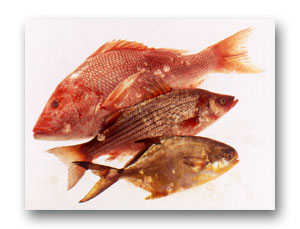
The Art of Dining

You've made your entrance, and you've even managed to steal a few hearts in the process of locating Mr. Right. Now that you know who he is, it is imperative that you pay careful attention to the guidelines surrounding proper table etiquette. Not only will it be embarrassing if you use the wrong fork or sip your soup the opposite way, but such wrongdoings could give your prospective man a reason not to get involved.
First of all, when you sit down, sit erect in your chair, keeping your feet squarely and firmly on the floor. Your chest should be approximately 8 inches from the table so that you are not hovering or reaching over the table. You should follow the host/hostesses lead, placing your napkin on your lap by opening it halfway and placing it across your knees with the fold toward you. As your parents always said to you when you were a child, "Keep you elbows in, low and off the table." If grace is said, keep your hands on your lap with your head respectively bowed until the end of prayer. Your attitude shows your host/hostess that you appreciate their blessing on you (Lane 39-40).
Okay, now that you know about the pre-dining preparation, let's eat!!
In order to find out the proper way to eat each of the following courses, click on the picture of the particular food item and you will be given instructions.
|
First Course
|
Second Course
|
Third Course
|
Keep this in mind when you are using a fork or spoon: each should be held firmly in the right hand with the thumb and first two fingers, keeping the prongs/bowls directed upward.
Before we discuss the main course, consider these suggestions when you engage in conversation: Be relaxed at the table. You want to enter conversation to ease the host/hostess, which will bring about a pleasurable atmosphere for everyone. However, be sure not to leave others out of the conversation. Also, be careful when choosing conversation topics. Avoid gossip, scandal, arguments or subjects that are "too personal," and never ever discuss your diet or your distaste for certain foods. As long as you smile and behave in a friendly, attentive and interactive manner, you will, no doubt, impress your man! (Gardner 27).
It's now time for the main course, which entails fish, a piece of meat, potatoes, and asparagus.
 |
 |
 |
 |
Now that your main course is finished, there are further rules regarding your utensils: 1. Never permit the silverware to touch the linen after it has been used. 2. Place your fork, prongs up, near the center of the plate with the handle coming out to the lower right-hand corner of the plate. The knife should then join on the outside of the fork, with the edge towards you. 3. Do not place your napkin on the table until the host/hostess does so, at which time you should fold it and place it at the left-side of your plate (24).
Now put that napkin back on your lap...it's time for dessert!
Though dessert is yummy, many people enjoy drinking at such social gatherings, but keep this in mind...
Here are some side-notes you may want to consider as well. If something drops, allow a servant to retrieve it, regardless of whether it is a utensil or a piece of food. If your napkin falls off your lap, only pick it up and place it back in your lap if you can do so in a casual manner. However, if you think you will cause a disturbance by picking it up, inform your host/hostess and he/she will take care of it for you(Gardner 23, Lane 39).
Dinner is finished, and if you have followed these guidelines, you are one step closer to landing Mr. Right.
Get prepared to.....
or
Shrimp and Oysters
You don't need to eat the shrimp whole. If they are served as part of a cocktail, they can usually be cut with the fork easily. If they are boiled fresh, you may simply peel the shell and use your fingers to dip the shrimp in a cocktail sauce. Don't forget to keep your mouth closed!!
Oysters are a little different from the shrimp. They are a part of your first course and therefore need to be eaten whole since their insides are unappetizing to look at. If you receive a bowl of cocktail sauce with your oysters, you may dip them once with your fork and then swallow whole. Use the outer most fork for this course-- it will be a little bit smaller than most of your other forks. If the plate of shrimp and oysters is served with a fork, use that fork instead of one of the ones provided on the table.
Don't forget, you should not eat until all the guests are served and the host/hostess takes up his/her own utensil. This rule pertains to all courses.
Quite possibly, after such a course, the servants will bring around finger bowls. If this occurs, simply dip your finger tips into the lemon/water based liquid and then gently wipe your fingers on your napkin (Stratton 68).
Salad
You may be thinking: "Salad--easy enough". Wrong. Which fork do you use? How do you cut the leaves when they are too big? What if you don't like some of the garnish in the salad? The outermost fork on the table is the one you will use. Keep in mind, though, It may be the second or third fork depending on whether or not you used a fork for the first course. Just remember, after every course, the fork used in accordance with that course is taken away. Therefore, if you ever doubt which fork, always go to the one that is on the outside. As for cutting…DO NOT cut your lettuce with a knife. If you must, use the side of your fork to do so. However, you should learn how to roll the lettuce around the fork so that it is a manageable bite-size. As for garnishes that you do not wish to eat, simply push them to side of your plate while you are eating. You do not need to eat everything, but you should always try something from every course. If you do not make a big deal out of it, no one else will. Have a couple of bites and engage in conversation the rest of the time.
Keep in mind, bread will be on the table at all times. In this case, make sure to butter each bite of bread seperately, rather than buttering your slice of bread as a whole (Gardner 21).
Soup
With soup, a lot of it is common sense. First, dip your spoon toward the outer edge of the bowl. Second, in order to prevent the liquid from dripping off the spoon while you eat it, avoid filling the spoon to the brim. When sipping, do so NOISELESSLY! Chances are the soup is going to be served very hot. If this happens, do not blow on it to make it cooler. Engage in conversation, taking a sip occasionally until it is at a manageable temperature. When you come to the end, do not tip the bowl or drink the remainder of the soup. Finally, when you are finished, do not place your spoon in the bowl. Instead, place it bowl-side down on the flat plate on which the soup bowl was served.
Just so you know, you should not use your napkin too frequently. However, you should make sure to always wipe your mouth before you take a drink in order to avoid leaving marks on the glass. In addition, when using your napkin throughout the meal, remember to gracefully pat the edges of your mouth (Gardner 22).
Fish
Often fish can be cut with the edge of a fork. Be aware, though, that there may be a few bones in your fish, no matter how carefully it is prepared. If you happen to find a bone in your mouth, all you can do is attempt to remove it with your thumb and forefinger as nonchalantly as possible. In addition, never put food, in this case fish, on your fork until you are prepared to eat it. You don't want to be caught talking to someone with fish on your fork in mid-air(Stratton 69).
Meat
The most important thing about meat is the way you cut it. The fork needs to be held in the left hand with prongs downward and the handle pressing into the palm. Your index finger should be extended in a straight line down the handle, with the knife in your right hand the same way. Make sure that this index finger does not venture below the hilt of either the knife or fork. In addition, when actually cutting the meat, it is important that the knife is positioned outside of the fork. Be conscious as to what you are doing with your food. Do not lick or nibble your meat, eat it! Meat is a difficult food because some people do not like the way it is prepared, and therefore, they will only have a couple of bites. If this happens to you, do not fiddle with the table while you are not eating. Instead, simply keep your hands folded in your lap. Any time that you are not using the knife throughout the meal, place it on the upper right edge of the plate, blade edge toward you (Stratton 55).
Potatoes
At a ball, chances are the baked potatoes will already be cut open, so use your fork to pull it apart. Next, add salt, pepper and butter, if you like, but do not cover the entire potato at once. Instead, when adding condiments, only add them to a fourth of the potato at a time. Whenever you are scooping or buttering the potato, always use a fork for this procedure. The skin is edible and considered a "choice morsel," so do not hesitate to eat it. This could be a difficult task if just using your fork, so when cutting the skin of the potato, you may use your knife (Stratton 57).
Often, asparagus is served with a buttery sauce (which by the way, is fabulous!) Some people have been seen eating this vegetable with their fingers, but this is improper. Eat the soft part of the asparagus with your fork and leave the remainder on your plate (Lane 33).
Coffee/tea and dessert
Chances are you will be served something like pie a la mode or strawberry shortcake with ice cream. There is no need to worry about figuring out which utensil to use with this course because your dessert will be served with a fork and spoon. You will also be able to choose whether you'd rather have tea or coffee, which will also be served with a spoon. When stirring the coffee/tea, do so as quietly as possible and place the spoon on the saucer, bowl side down (do not place it in your empty cup after you have finished the drink). The lumps of sugar will be served with tongs, which should be held with your thumb and forefinger. Remember...always wipe your mouth with the napkin before you take a sip...heaven forbid you should leave a lipstick mark on your coffee/tea cup(Gardner 25).
As for your beverages, try not to drink too much. It may appear as though you are filling up on water or wine as an excuse not eat that which you do not like. Plus, if you drink too much, you'll never be able to hold an appropriate conversation with Mr. Right!! (Stratton 71)
Back to parting words of advice